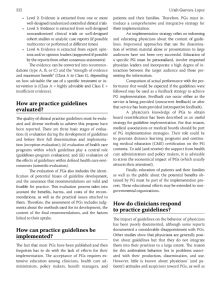Page 344 Guide to Pain Management in Low-Resource Settings
P. 344
332 Uriah Guevara-Lopez
• Level 2: Evidence is extracted from one or more patients and their families. Th erefore, PGs must in-
well-designed randomized controlled clinical trials troduce a comprehensive and integrative strategy for
• Level 3: Evidence is extracted from well-designed their implementation.
nonrandomized clinical trials or well-designed An implementation strategy relies on informing
cohort studies or analytic case reports (if possible and educating physicians about the content of guide-
multicenter or performed at diff erent times) lines. Impersonal approaches that use the dissemina-
• Level 4: Evidence is extracted from expert opin- tion of written material alone or presentations to large
ions and/or opinion leaders (supported if possible audiences have not been very successful. Education of
by the reports from other consensus statements) a specifi c PG must be personalized, involve respected
Th e evidence can be converted into recommen- physician leaders and incorporate a high degree of in-
dations (type A, B, or C) and the “strength of evidence teraction between the target audience and those pre-
and maximum benefi t” (Class A to Class E), depending senting the information.
on how advisable the use of a specifi c treatment or in- Comparison of actual performance with the per-
tervention is (Class A = highly advisable and Class E = formance that would be expected if the guidelines were
insuffi cient evidence). followed may be used as a feedback strategy to achieve
PG implementation. Feedback can occur either as the
How are practice guidelines service is being provided (concurrent feedback) or after
that service has been provided (retrospective feedback).
evaluated?
A physician’s knowledge of PGs to obtain
Th e quality of clinical practice guidelines must be evalu- board recertifi cation has been described as an useful
ated and diverse methods to achieve this propose have strategy for guideline implementation. For that reason,
been reported. Th ere are three basic stages of evalua- medical associations or medical boards should be part
tion: (i) evaluation during the development of guidelines of PG implementation strategies. Th eir role could be
and before their full dissemination and implementa- to generate distance learning programs and continu-
tion (inception evaluation); (ii) evaluation of health care ing medical education (CME) certifi cation on the PG
programs within which guidelines play a central role contents. To add (and receive) the support from health
(guidelines-program evaluation); and (iii) evaluation of care administrators and policy makers, it is advisable
the eff ects of guidelines within defi ned health care envi- to stress the economical impact of PGs (which usually
ronments (scientifi c evaluation). attracts their attention!).
Th e evaluation of PGs also includes the identi- Finally, education of patients and their families
fi cation of potential biases of guideline development, as well as the public about the potential benefi ts ob-
and the assurance that recommendations are valid and tained by PG must be part of the implementation pro-
feasible for practice. Th is evaluation process takes into cess. Th ese educational eff orts may be extended to non-
account the benefi ts, harms, and costs of the recom- governmental organizations.
mendations, as well as the practical issues attached to
them. Th erefore, the assessment of PGs includes judg- How do clinicians respond
ments about the methods used for its development, the to practice guidelines?
content of the fi nal recommendations, and the factors
linked to their uptake. Th e impact of guidelines on the behavior of physicians
has been poorly documented, although some reports
How can practice guidelines be documented a considerable disappointment with PGs.
implemented? Other studies show that physicians are generally posi-
tive about guidelines but that they do not integrate
Th e fact that most PGs have been published and then them into their practices to a large extent. Th e reason
forgotten has to do with the lack of eff orts for their for this ambivalent behavior lies in problems associ-
implementation. Th e acceptance of PGs requires ex- ated with their production, dissemination, and use.
tensive education among clinicians, health care ad- However, little is known about physicians’ (and pa-
ministrators, policy makers, benefi t managers, and tients’) attitudes and suspicions toward PGs, as well as


